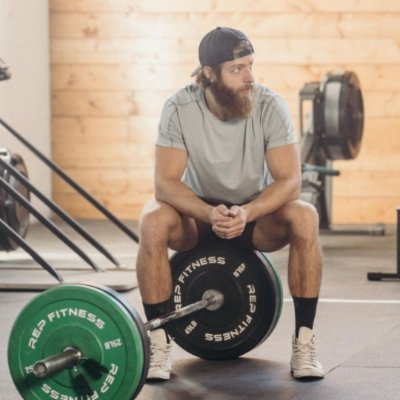The trap bar deadlift, with its high and low handles, is a versatile training tool that I regularly use with my own training and for my clients. I’ll program low-handle versus high-handle trap bar deadlifts for different based on the goals at hand.
Whether you want to build your general lower body strength, top-end strength output, improve your barbell deadlift, or just don’t want to barbell deadlift, the trap bar could be beneficial for you.
In this article, I’ll cover low-handle trap bar deadlifts versus high-handle trap bar deadlifts and how to use both to achieve your strength and muscle-building goals.
For Those In a Rush: If your goal is building or biasing your legs, then opt for low-handle trap bar deadlifts. You’ll work through greater degrees of hip and knee flexion with them. Opt for high-handle trap bar deadlifts for a posterior bias and general back strength.
High-Handle Vs Low-Handle Trap Bar Deadlifts
There are countless differences between low-handle trap bar deadlifts versus high-handle trap bar deadlifts and if you can understand their key differences, then you can use them more appropriately per your training.
1. Different Handles Height Equal Different Outcomes
A high-handle trap bar deadlift occurs when the trap bar’s handles are facing upwards, resulting in less range of motion needed to lift the weight. Low-handle trap bar deadlifts occur when the handles are facing down, and you’ll have to move through a greater range of motion.
In practice, a low-handle trap bar deadlift somewhat replicates squat mechanics, as you’ll have to bend down further to grab and pick up the weight. To do this, you’ll have to go into greater degrees of hip and knee flexion.
The high-handle trap bar deadlift will look somewhat similar to a barbell deadlift regarding setup, range of motion, joint angles used, and needed to lift and move the weight.
When you hear “deadlift,” it’s normal to think of posterior muscles like the hamstrings and glutes, but in both low-handle and high-handle trap bar deadlifts, the quads will also be highly engaged, just to different degrees.
Generally speaking, low-handle trap bar deadlifts will require more effort as you lift weight through a larger range of motion. Plus, the starting position in low-handle trap bar deadlifts will require more effort as you’ll be more disadvantaged lifting from a deeper range of motion from a dead stop position.
On the flip side, you can typically perform high-handle trap bar deadlifts for higher-volume sets with heavier weights, which can be great for multiple reasons. First, it’s a nice way to build your pulling capacity, which can carry over to deadlifts.
Second, since you’re not fatiguing as fast with high-handle trap bar deadlifts, they can help you build your grip strength, upper back muscles, and legs and back in ways that sometimes a barbell deadlift can fall short of due to the skill requirements and fatigue they can cause.
2. Low-Handle Trap Bar Deadlifts Can Be Great for the Legs
Compared to high-handle trap bar deadlifts, low-handle trap bar deadlifts will give you more “legs” across the board. Something to note is that your height will also factor into the “how much” you get with low-handle trap bar deadlifts.
For example, I’m 6′ 0″ with pretty long legs so to get into the bottom position of a low-handle trap bar deadlift, my joint angles will replicate angles that you typically see towards the bottom of my high-bar back squats.
This means that as my knees exceed 90 degrees of flexion, I’ll have more demands on my quads, and with the deeper hip flexion, I’ll have more adductor activity as well. Shorter lifters may experience different degrees of leg work with this variation.
However, you can always expect low-handle trap bar deadlifts to hit the legs more than high-handle trap bar deadlifts solely due to how much you have to bend down to get into position and initiate the lift.
Another perk that comes along with low-handle trap bar deadlifts for leg growth is that you have to initiate this movement from a dead-stop position. This can be great for building your overcoming strength and power.
I liken this variation sometimes to bottoms-up squats; while there’s obviously a difference between a low-handle trap bar deadlift and a bottoms-up squat due to grip demands, how the weight is displaced, and the skill needed to execute these movements, the idea is similar.
3. High-Handle Trap Bar Deadlifts Can Be Easy to Manipulate
Unlike their lower-handle peers, high-handle trap bar deadlifts are typically a little more beginner-friendly in terms of how easy it is to learn how to do them and execute them with quality form.
Since the hands are by the sides, it can often feel a little more “natural” for lifters to perform high-handle trap bar deadlifts compared to traditional deadlifts. This is also because you don’t have to worry about clearing the barbell around the knees as you do with barbell deadlifts.
This lack of clearing the knees will then allow lifters to more use their quads with high-handle trap bar deadlifts which is also why it can not only be easier to perform this variation but why lifters can often perform them for higher volumes.
Compared to low-handle trap bar deadlifts, I often find that high-handle trap bar deadlifts can be a little easier to manipulate. Since the hips start at a higher position, it can be easier to create more or less posterior bias with your execution with this variation.
What I mean by this is that if you wanted to create a larger glute and hamstring bias with your high-trap bar deadlift, then it’s easier to bring the hips up and bend the knees less since the handles are higher. You can typically maintain a strong torso angle without changing too much when doing this.
Note, if you tried this with a low-handle trap bar deadlift, then you’d have a lot more to think about with your torso position and some lifters might find this uncomfortable.
All that said, high-handle trap bar deadlifts can be an awesome tool to play with when you’re learning deadlift mechanics and playing with your knee and hip angles to create more or less quad and glute-biased movement mechanics.
Benefits of Low-Handle Trap Bar Deadlifts
If you’re wanting to experiment and program low-handle trap bar deadlifts more for your workouts, then it’s a good idea to familiarize yourself with a few of their benefits.
With programming different exercises, oftentimes a movement’s benefits will be accompanied by the “why” behind the exercise’s goals for your training needs.
1. Great for Lower Body Development
As mentioned above, low-handle trap bar deadlifts can be great for building the legs, and more specifically, the quads, hamstrings, and glutes. In low-handle trap bar deadlifts you’ll work through greater degrees of knee and hip flexion.
This can be great for adding a little extra stress on the quads when starting your deadlift and the glutes will have to work harder to extend the hips as you lift the weight through the larger range of motion.
Another lower body-building perk is that low-handle trap bar deadlifts start you from a dead-stop position. To initiate your low-handle trap bar deadlift reps, the lower body will have to work hard to produce force into the ground.
In traditional squats, you have the stretch-shortening cycle in play as you transition from the eccentric to the concentric, and when doing low-handle trap bar deadlifts this is taken away.
2. Good for Teaching Squat Mechanics
Another benefit of low-handle trap bar deadlifts for beginners is that they can be a useful tool to teach proper squat mechanics. As you lock out your deadlifts and with the hands by the side, you’ll have to break evenly at the hips and knees to bring the weight back down.
This can create carryover to squats as you’ll typically also want to have an even break at the knees and hips when performing things like high-bar back squats.
On that note, and compared to something like a high-bar back squat, the low-handle trap bar deadlift typically has a lower skill component to it so it can somewhat expedite the learning process of what needs to happen at the hips and knees during squats.
Keep in mind, this is not to say low-handle trap bar deadlifts are exactly like squats as there are countless differences, but they can create some carryover for beginner lifters wanting to improve and fine-tune their squat mechanics.
3. Sneaky Core and Back Builder
The final underappreciated benefit of low-handle trap bar deadlifts is that they can be great for building your core and back strength. When you set up for low-handle trap bar deadlifts you’ll want to maintain a more upright torso for balance purposes.
As the weight on the bar gets heavier, the muscles of the torso are going to have to work harder to maintain their positions or at least help you stay within a form deviation that allows you to perform your reps with efficiency.
For example, I’m always shocked (in a good way) at how much my upper back, core, and back muscles in general get blown up after higher volume low-handle trap bar deadlift days.
On top of this, since the torso has to work harder to maintain its more upright position you can also see a nice carryover benefit with low-handle trap bar deadlifts to squat variations like front squats, high-bar squats, and Zercher squats.
Benefits of High-Handle Trap Bar Deadlifts
In the context of my workouts, I typically program high-handle trap bar deadlifts a little more frequently than low-handle trap bar deadlifts due to their benefits.
High-handle trap bar deadlifts can have a ton of applications for general life, strength sports, and traditional sports.
1. Great for Building Pulling Strength
The first benefit of high-handle trap bar deadlifts is that they can be awesome for building your general pulling strength. A high-handle trap bar deadlift setup will somewhat replicate the hip position needed for barbell deadlifts.
This can be great for training your hip extension strength when working with heavier weights. Plus, you’ll get more quad involvement with high-handle trap bar deadlifts due to the arms being by the side.
One area that I constantly see lifters miss out on when it comes to their barbell deadlift potential is utilizing their quads more when breaking the floor, AKA initiating their barbell deadlifts.
With high-handle trap bar deadlifts you can familiarize yourself with using the quads more when pulling which can be awesome for barbell deadlift carryover. I’ll often program high-handle trap bar deadlifts for my clients that have trouble in the first part of their deadlift for this reason.
2. Can Be Awesome for Building the Hamstring and Glutes
Another benefit that comes with high-handle trap bar deadlifts is how easily they can be manipulated to focus on the glutes. If you bring your hips a little higher when performing high-handle trap bar deadlifts then you’ll shift emphasis from the quads and more to the posterior muscles.
In practice, doing this will essentially make your high-handle trap bar deadlifts look a little more like stiff-legged barbell deadlifts as you’ll have less knee flexion and greater emphasis on your hip flexion and extension.
Unlike stiff-legged barbell deadlifts, though, a high hip high-handle trap bar deadlift can oftentimes be easier to learn and perform at higher volumes since the arms are to the side. I liken this to dumbbell deadlifts for beginners but you can take these heavier.
3. Useful for Teaching Hip Hinge Mechanics
From a coaching perspective, I really like how high-handle trap bar deadlifts can teach hip hinge mechanics, especially when moving heavier weights.
Generally speaking, I’ll start by teaching the hip hinge unloaded, then move to dumbbells, and then shift to high-handle trap bar deadlifts or barbell RDLs depending on a client’s training goals and proficiency.
A sneaky way that I’ll use high-handle trap bar deadlifts to teach hip hinge mechanics is to have a client lift weight like normal, then as they initiate their eccentric utilize a hip hinge to bring the weight down.
Outside of teaching hip hinge mechanics, this can also be a fun challenge to build one’s knowledge of different movements. If you’re trap bar deadlifting like normal in the concentric (lifting portion), then hinging through the eccentric (lowering portion), you’ll build your ability to shift your mindset based on movement goals.
Frequently Asked Questions (FAQ)
Q:Should you use high or low handle for trap bar deadlift?
Q:What muscles do low handle trap bar deadlifts work?
Q:Which handle for trap bar deadlift?
Takeaway Thoughts
When considering the high-handle trap bar deadlift versus the low-handle trap bar deadlift, I’d suggest learning your exercise selection based on your training goals.
The low-handle and high-handle trap bar deadlift can both be fantastic trap bar deadlift variations for different reasons. By experimenting with both you can learn more about how your body responds to each variation.
If you have additional questions about programming and using high-handle and low-handle trap bar deadlifts, drop a comment below or reach out to me personally via Instagram (@jake_boly or @that_fit_friend).






















Add a Comment